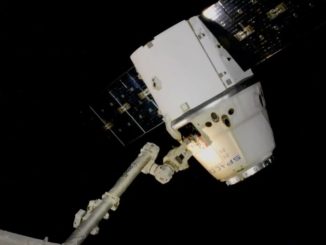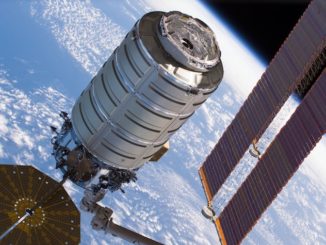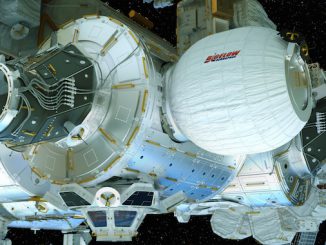Updated at 1 p.m. EST (1800 GMT) Thursday.
Russian mission control said Thursday an unpiloted Progress space station supply ship carrying nearly 5,400 pounds of rocket fuel, food, water and a new spacesuit burned up in Earth’s atmosphere shortly after it blasted off from Kazakhstan, and evidence points to a problem with the third stage of the cargo carrier’s Soyuz booster.
The Russian space agency — Roscosmos — confirmed the demise of the Progress MS-04 cargo craft in a statement, saying the automated spaceship was lost as it flew nearly 120 miles (190 kilometers) over the Tuva Republic in Southern Russia.
Engineers lost telemetry during the Soyuz rocket’s third stage engine burn, and most of the vehicle’s fragments burned up in the atmosphere, Roscosmos said.
The spacecraft lifted off from the Baikonur Cosmodrome in Kazakhstan at 1451:52 GMT (9:51:52 a.m. EST; 8:51 p.m. Baikonur time) Thursday, roughly the moment the Earth’s rotation brought the remote Central Asia spaceport in line with the space station’s flight path.
The three-stage kerosene-fueled Soyuz booster heaved the cargo ship northeast from Baikonur and dropped its four strap-on boosters around two minutes after liftoff. An aerodynamic shield covering the Progress spacecraft jettisoned a few minutes later, followed by separation of the Soyuz core stage and ignition of the rocket’s third stage RD-0110 engine.
But Russian mission control lost contact with the rocket and its cargo payload at around T+plus 6 minutes, 22 seconds, according to Roscosmos. That was more than two minutes before the Progress spacecraft was to arrive in orbit.
The flight proceeded normally until that point, Russian officials said.
If all went according to plan, the Soyuz launcher should have deployed the cargo capsule into a preliminary orbit less than nine minutes into the flight. The Progress MS-04 spacecraft should have extended its power-generating solar panels and navigation antennas almost immediately after separating from the Soyuz upper stage.
But “ratty” telemetry from the spacecraft left ground controllers struggling to verify the status of the Progress cargo freighter. Rob Navias, a NASA TV commentator covering the launch, reported there was some indication the Soyuz third stage and Progress supply carrier may have prematurely separated.
“Our astronauts and the Russian cosmonauts are safe aboard the station,” a NASA spokesperson said in a statement. “Consumables aboard the station are at good levels.”
NASA astronaut Jessica Meir gave station commander Shane Kimbrough some “not-so-good news” a few hours after the launch.
“We have some news about the Progress,” Meir radioed from mission control in Houston. “Basically, what we saw was indications of the third stage sep (separation) occurring a few minutes early, and we haven’t had any communications with the Progress at all, so the Russians are, of course, looking into this, and we will inform you when we get more status.”
“OK, thanks, Houston, for the words,” Kimbrough replied. “Please keep us updated whenever you hear something.”
“We’ll continue to keep updating,” Meir said. “The Russians have sent the Progress team home at this point, and they have formed a State Commission.”
“Copy all,” Kimbrough said.
Russian space officials typically form State Commissions to investigate launch failures.
Thursday’s launch failure marks the fourth time in 25 months that a supply ship heading for the space station has fallen short of the complex.
A commercial Orbital ATK Cygnus cargo freighter crashed moments after liftoff in October 2014 when its Antares booster suffered an engine failure, then a Russian Progress spacecraft spun out of control after a botched separation from its Soyuz rocket in April 2015. SpaceX’s Falcon 9 rocket disintegrated in mid-air on a June 2015 launch with a Dragon logistics capsule.
That record signifies a turnaround in fortune for the international research outpost. Only one mission to the space station failed — another Soyuz/Progress launch in August 2011 — in nearly 16 years of assembly and resupply missions from November 1998 through October 2014.
Part refueling vehicle, reboost tug and resupply ship, the Progress logistics craft was embarking on a two-day chase of the space station, with a series of orbital maneuvers planned before targeting an automated docking with the outpost’s Zvezda service module around 1643 GMT (11:43 a.m. EST) Saturday.
The supply carrier’s official manifest included 5,383 pounds (2,442 kilograms) of cargo, a figure encompassing 1,565 pounds (710 kilograms) of propellant to be pumped into the Zvezda module’s fuel tanks, 926 pounds (420 kilograms) of fresh water, 114 pounds (52 kilograms) of oxygen, and 2,777 pounds (1,260 pounds) of dry cargo inside its pressurized cabin, according to information provided on the Russian space agency’s website.
The resupply mission was the 65th Progress spacecraft to launch toward the International Space Station since 2000, and the third Progress flight of the year.
A list posted on the Roscosmos website indicated the Progress MS-04 mission was to deliver about 694 pounds (315 kilograms) of food for the space station’s crew, 253 pounds (115 kilograms) of medical gear, personal hygiene items, and health monitoring equipment, 183 pounds of supplies for the Russian segment’s toilet and waste containers, and 147 pounds (67 kilograms) of hardware for the station’s air purification system.
Russian technicians also packed a new Orlan spacesuit inside the Progress MS-04 spacecraft to be used by Russian cosmonauts on future spacewalks. Also aboard the supply mission were myriad cables, photographic equipment and science experiments.
There were 191 pounds (87 kilograms) of supplies for NASA stowed on-board for the station’s environmental control and water recycling systems, according to Roscosmos.
Another resupply mission is due for launch to the space station Dec. 9, when a Japanese HTV cargo freighter will lift off with more experiments, provisions and six lithium-ion batteries to begin a major overhaul of the research lab’s U.S. power system.
Email the author.
Follow Stephen Clark on Twitter: @StephenClark1.



